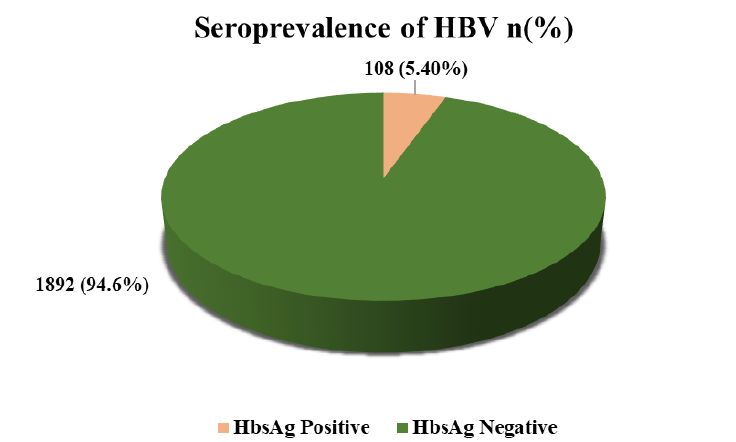SEROPREVALENCE OF HEPATITIS-B VIRUS INFECTION IN SLUM POPULATION OF DHAKA CITY, BANGLADESH
Abstract
Background: Hepatitis B virus (HBV) infection is a significant global health concern, particularly in developing countries. While previous studies in Bangladesh have reported varying HBV prevalence rates, data specific to urban slum populations is limited.
Objective: Aim of the study was determine the seroprevalence of HBV infection among slum dwellers in Dhaka City, a population potentially at high risk due to socioeconomic and environmental factors.
Methods: This cross-sectional study was conducted from July 2006 to June 2007, involving 2,000 adults randomly selected from slum clusters in Dhaka city, Bangladesh. Participants completed a structured questionnaire covering socio-demographic information was blood samples were collected and tested for HBsAg using test strips, with positive results confirmed by ELISA.
Results: The study revealed hepatitis-B virus infection seroprevalence of 5.40% among the 2,000 participants (mean age 31.91 ± 11.34 years, 59% female). Knowledge about HBV was notably low, with only 7.06% aware that hepatitis could be caused by an infectious agent and 53.99% unaware of transmission modes. HBV vaccination coverage was extremely low at 2.33%. High-risk behaviors were identified, including receiving injections from unqualified providers (16.96%) and using disposable syringes (20.91%). Significantly, HBsAg positivity was associated with male gender (p=0.002), younger age (mean 28.78 ± 10.78 years, p=0.013), and household water supply (p=0.0001). None of the HBsAg-positive cases had received HBV vaccination (p<0.05).
Conclusion: The study reveals a significant HBV seroprevalence in Dhaka's slum population, coupled with low levels of awareness and preventive behaviors. These findings underscore the urgent need for targeted public health interventions, including education campaigns, accessible vaccination programs, and improved healthcare services tailored to the unique challenges of urban slum communities.
Downloads
References
Madrey WE. Hepatitis B. An important public health issue. J Med Virol, 2000; 61: 362 6.
Lee WM. Hepatitis B virus infection. N Engl J Med, 1997; 337: 1733.
Beasley RP, Hwang LY, Lin CC, Leu ML, Stevens CE, Szmuness W, et al. Incidence of hepatitis B virus infection in preschool children in Taiwan. J Infect Dis 1982; 146: 198-304.
McMahon B, Rhoades E, Heyward W, et al. A comprehensive program to reduce the incidence of hepatitis B virus infection and its sequelae in Alaska natives. Lancet 1987, 2:1134.
Alter M, Hadler S, Margolis H. et al. The changing epidemiology of hepatitis in the Unites States. Need for alternative vaccination strategies JAMA 1990, 263: 1218.
Rahman M., Amanullah, H Sattar, M Rahman, HA Rashid, AS Mollah. Seroepidemiology of HBV infection in village. BMRC: Counsel Bull 1997; 38-41.
Khan Mobin, N Ahmed. Seroepidemiology of HBV and HVC in Bangladesh. International Communication of Hepatology 1996; 5: 27-29.
Safiullah ABM. Seroprevalence of hepatitis B virus and hepatitis C virus infection and clinical signs of chronic liver disease in rural adult population. MD Thesis 2007. BSMMU, Dhaka.p.67.
Mustofa M, N Islam, M. Rahman. Journal of preventive and social medicine. June 1991; 10: 22-26.
Shahidullah M, Hafez MA, Rahman MM, Hossain MM. JOPSOM, 1998; vol. 17(2) : 116-120.
H Ashraf, Rothermundt C, Alam NH, Bardhn PK, Hossain I, Brooks A. Prevalence and risk factors for hepatitis B and hepatitis C virus infectons in a selected community of Dhaka City, Bangladesh. Gut 2006; 55 (Suppl V) A 147.
Laura Gibney, Saquib N, Metzger J, Chowdhury P, Siddiqui MA, Hassan MS. Human immunodeficiency virus, hepatitis B, C and D in Bangladesh's trucking industry: prevalence and risk factors. International Journal of Epidemiolgy 2001; 30: 878-884.
Shirin T, Ahmed T, Iqbal A, Islam M, Islam MN. Health Population Nutr. 2000; 18(3): 145-50.
Chowdhury AW, Karim MZ, Ahmad Q, Hossain MZ, Chowdhury SGM. Study of knowledge, attitude, behaviors and practice of junior doctors and nurses regarding Hepatitis B virus. BMRC no. 1436.



























